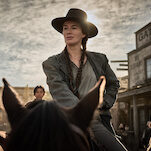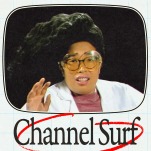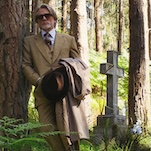Right from the wordless opening sequence, Montgomery demonstrates a keen understanding of how to tell a story in images. After getting off a bus in a dusty, mostly Latino town in New Mexico, Lucky Gagin (Montgomery) tosses a small piece of paper into a bus-station locker, buys a pack of chewing gum from a vending machine, and surreptitiously sticks the locker’s key on the wall behind a large painting. His goal, it gradually emerges, is to blackmail a criminal kingpin named Frank Hugo (Fred Clark), who’d killed Gagin’s pal Shorty some time earlier when Shorty attempted to do the same. Along the way, Gagin falls for a Mexican-American peasant girl, Pila (played by the not-remotely Mexican Wanda Hendrix); befriends a jovial Mexican-American carousel operator, Pancho (Thomas Gomez, whose Best Supporting Actor nomination for this role was the first Oscar nod for a Latino-American actor); and parries with a federal agent, Bill Retz (Art Smith), who’s in town trying to arrest Hugo and fears Gagin may kill him.
Like a lot of actors who start directing, Montgomery usually cast himself in the lead role—that may well have been the only way he could get the movies made. Tough guys weren’t his forte, unfortunately, and his performance in Ride The Pink Horse is among the film’s weakest elements. That’s especially true of his scenes opposite Clark, who makes Hugo a disturbingly low-key, all-business villain, with an ostensible disability—a hearing aid—that somehow only makes him seem more formidable. Nor does the movie know what to do with Pila, since an actual romance between a white man and a non-white woman was unthinkable in 1947 Hollywood. Mostly, she just follows Gagin around, having decided, for no very good reason, that he’s a wonderful fellow who needs her unceasing support and attention. Their final scene together is oddly unsatisfying, as is the didactic showdown between Gagin and Hugo.
In spite of those demerits, however, Ride The Pink Horse still manages to make an impression, thanks largely to Montgomery’s considerable skill behind the camera. Working with the great cinematographer Russell Metty (who’d go on to shoot the ravishing Magnificent Obsession and Written On The Wind for Douglas Sirk), he makes the New Mexico town of San Pablo a singularly seedy location, replete with the standard noir shadows but also faintly ominous even in sunlight. The movie is full of bravura shots that continually re-frame the action without calling attention to their agility, as in that opening bus-station sequence that silently establishes Gagin’s disreputable intentions. Pink Horse even anticipates the climax of Hitchcock’s Strangers On A Train (made four years later), in a scene that shows a couple of Hugo’s thugs beating the crap out of Gagin from the dizzy perspective of freaked-out kids riding Pancho’s carousel. Judging from the evidence here, and to a lesser extent from Lady In The Lake, Montgomery could have been a major director, given more opportunities. It’s not as heartbreaking a case as that of Charles Laughton (whose sole film as director, The Night Of The Hunter, is among the greatest ever made), but it’s still cause for a bit of melancholy.
Ride The Pink Horse is available on Blu-ray and DVD from the Criterion Collection.









































